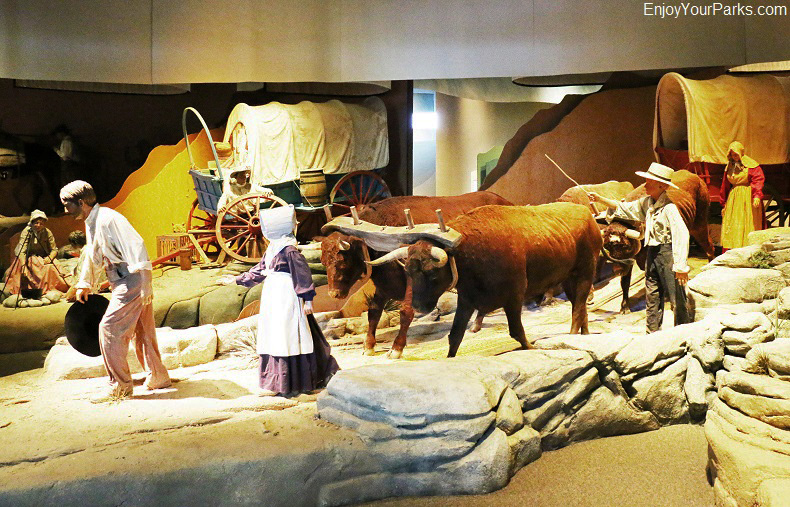Casper Wyoming Area Attractions
Fort Caspar Historic Site, Fort Caspar Museum, Tate Geological Museum
 Casper Wyoming is known as "The Oil City" because of its long history of being an oil boom town, but its absolutely incredible Old West history is the overwhelming attribute of this amazing Western town. Located in the east-central area of Wyoming along Interstate 25 at an elevation of over 5,000 feet above sea level on the high plains of Wyoming, Casper Wyoming's 55,000+ residents are surrounded by incredible Old West history and landmarks... from the fascinating Historic Trails Interpretive Center to Independence Rock State Historic Site to Fort Caspar State Historic Site and Museum, to the Tate Geological Museum, Casper Wyoming is a mecca for visitors interested in Old West history, which includes Native American, pioneer, cowboy and ranching history... and much more. There are many museums and attractions that will unfold the astounding history that occurred here. Nestled at the foot of Casper Mountain along the north end of the Laramie Range along the historic North Platte River, we strongly feel that Casper Wyoming is a "must see" for anyone fascinated with the history of the Old West during their Wyoming vacation.
Casper Wyoming is known as "The Oil City" because of its long history of being an oil boom town, but its absolutely incredible Old West history is the overwhelming attribute of this amazing Western town. Located in the east-central area of Wyoming along Interstate 25 at an elevation of over 5,000 feet above sea level on the high plains of Wyoming, Casper Wyoming's 55,000+ residents are surrounded by incredible Old West history and landmarks... from the fascinating Historic Trails Interpretive Center to Independence Rock State Historic Site to Fort Caspar State Historic Site and Museum, to the Tate Geological Museum, Casper Wyoming is a mecca for visitors interested in Old West history, which includes Native American, pioneer, cowboy and ranching history... and much more. There are many museums and attractions that will unfold the astounding history that occurred here. Nestled at the foot of Casper Mountain along the north end of the Laramie Range along the historic North Platte River, we strongly feel that Casper Wyoming is a "must see" for anyone fascinated with the history of the Old West during their Wyoming vacation.
Brief History of Casper Wyoming
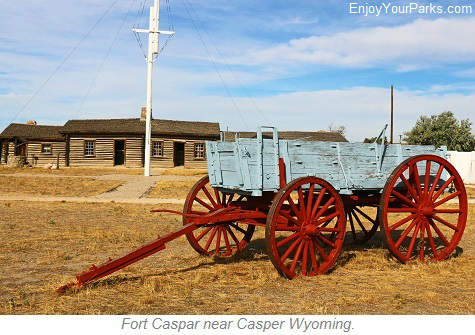 The town of Casper Wyoming was built just east of the original site of Fort Caspar, which was a popular place for emigrants to cross the North Platte River on their way along the Oregon Trail to the West Coast. There were several ferries providing this service beginning in the 1840s. Then in 1859 a bridge was built across the North Platte River, and a fort was built in 1859 on the banks of the North Platte River originally used as a trading post and toll for the pioneers needing to cross the North Platte River along the Oregon Trail via covered wagon, and later became a military post as the mass migration of pioneers poured onto the Oregon Trail, California Trail and Mormon Trail en route to the West Coast. When the U.S. Army took over the station they renamed it the Platte Bridge Station. Their objective was to protect emigrants using the Oregon, California and Mormon Trails from the frequent raids led by the Cheyenne and Lakota Indians during the ongoing wars between these two Indian tribes and the U.S. Government.
The town of Casper Wyoming was built just east of the original site of Fort Caspar, which was a popular place for emigrants to cross the North Platte River on their way along the Oregon Trail to the West Coast. There were several ferries providing this service beginning in the 1840s. Then in 1859 a bridge was built across the North Platte River, and a fort was built in 1859 on the banks of the North Platte River originally used as a trading post and toll for the pioneers needing to cross the North Platte River along the Oregon Trail via covered wagon, and later became a military post as the mass migration of pioneers poured onto the Oregon Trail, California Trail and Mormon Trail en route to the West Coast. When the U.S. Army took over the station they renamed it the Platte Bridge Station. Their objective was to protect emigrants using the Oregon, California and Mormon Trails from the frequent raids led by the Cheyenne and Lakota Indians during the ongoing wars between these two Indian tribes and the U.S. Government.
 Fort Caspar was named after 2nd Lieutenant Caspar Collins, a U.S. Army officer who was killed in the 1865 Battle of the Platte Bridge Station. The original site of Fort Caspar in Casper Wyoming is listed in the National Register of Historic Places, and the Fort Caspar Historic Site and Museum is a popular destination for vacationers visiting the Casper Wyoming area. The town of Casper Wyoming was actually founded years after Fort Caspar had been closed. The town of Casper was founded in June of 1888 when the tracks of the Fremont, Elkhorn and Missouri Valley Railroad arrived. The town was named after the nearby Fort Caspar, which was at that time in ruins. Named after Lt. Caspar Collins, who was killed by Indians in 1865, the reason Casper Wyoming is not Caspar Wyoming was due to a typo that happened during the official registration of the town in 1889.
Fort Caspar was named after 2nd Lieutenant Caspar Collins, a U.S. Army officer who was killed in the 1865 Battle of the Platte Bridge Station. The original site of Fort Caspar in Casper Wyoming is listed in the National Register of Historic Places, and the Fort Caspar Historic Site and Museum is a popular destination for vacationers visiting the Casper Wyoming area. The town of Casper Wyoming was actually founded years after Fort Caspar had been closed. The town of Casper was founded in June of 1888 when the tracks of the Fremont, Elkhorn and Missouri Valley Railroad arrived. The town was named after the nearby Fort Caspar, which was at that time in ruins. Named after Lt. Caspar Collins, who was killed by Indians in 1865, the reason Casper Wyoming is not Caspar Wyoming was due to a typo that happened during the official registration of the town in 1889.
Not long after the railroad arrived, Casper Wyoming became a very significant shipping point for wool and cattle, and buildings began to be built and the town began to grow. On April 9, 1889, Casper Wyoming officially became an incorporated town. But early on, Casper was a classic Wild West Town, with the classic saloons, brothels, gunfights, and everything else that one would picture an Old West Town to have. In time, the lawlessness was subdued by early law enforcement efforts...which is a fascinating story in and of itself.
The town leaders of Casper, once it became incorporated, quickly built a city water supply, schools, streets, a library, fire department and more. Then on July 7, 1890 the town's government moved into a two story brick building on Center Street, having a bell tower and large central hall. Casper was rapidly become a major center of commerce in the newly settled West.
Casper Wyoming Today
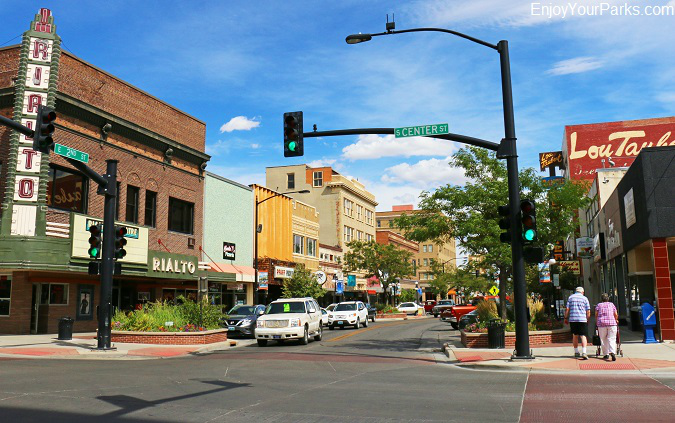
Casper Wyoming Downtown Historic District.
Casper today is known as "Wyoming's Adventure Capital", as this area offers an incredible combination of outdoor recreational activities, history, sporting events, lodging, dining, culture and air service. Casper has over 20 museums, a planetarium and an outstanding symphony orchestra. Outside Casper is an outdoor enthusiast's paradise, such as blue ribbon fly fishing on the North Platte River, hiking, rock climbing, camping and much more.
National Historic Trails Interpretive Center

National Historic Trails Interpretive Center in Casper, Wyoming.
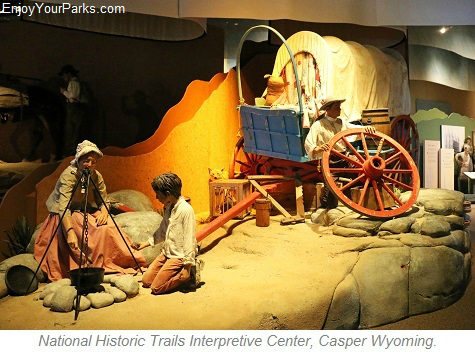 One of the true "gems" in Casper Wyoming is the National Historic Trails Interpretive Center. This 27,000 square foot state-of-the-art facility commemorates the brave pioneers who traveled along the historic Oregon Trail, California Trail and Mormon Trail on their way to the West Coast.
One of the true "gems" in Casper Wyoming is the National Historic Trails Interpretive Center. This 27,000 square foot state-of-the-art facility commemorates the brave pioneers who traveled along the historic Oregon Trail, California Trail and Mormon Trail on their way to the West Coast.
The National Historic Trails Interpretive Center is absolutely amazing, and is without question a "must see" while visiting the Casper Area during your Wyoming vacation. Once you enter this incredible interpretive center, you'll be captivated and fascinated as you and your family are taken back to the time of the Great Western Migration that changed America forever. We cannot stress enough just how impressive and interesting the National Historic Trails Interpretive Center is, and it will definitely be one of the highlights of your vacation for those of you interested in important and fascinating Old West history.
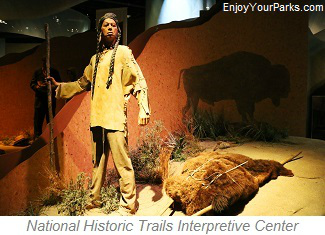

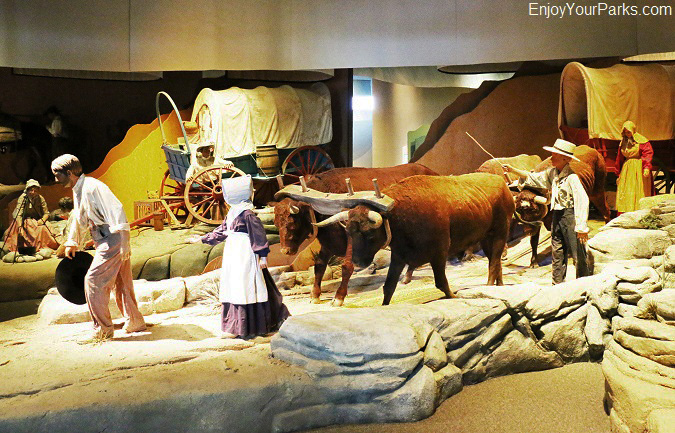
National Historic Trails Interpretive Center, Casper Wyoming.
Rodeos!
Casper is home to several major rodeos, such as the College National Finals Rodeo each June, as well as the Central Wyoming Fair and PRCA Rodeo. This PRCA Rodeo is an important rodeo for cowboys and cowgirls who are trying to qualify for the PRCA National Finals Rodeo in Las Vegas each year.
Tate Geological Museum
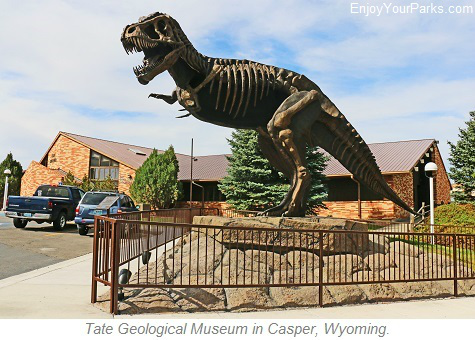 The Tate Geological Museum is another major attraction in Casper Wyoming, and is home to 3,000 mineral and fossil specimens....including dinosaurs!
The Tate Geological Museum is another major attraction in Casper Wyoming, and is home to 3,000 mineral and fossil specimens....including dinosaurs!
Also found at the Tate Geological Museum in Casper Wyoming is one of the most complete T Rex skeleton found in Wyoming, as well as an 11,600 year old Mammoth they call "Dee". This ancient Mammoth skeleton is the largest mounted Columbian Mammoth found in North America, standing nearly 14 feet tall! There are countless exhibits throughout the complex that not only will astound you, but will spark the imagination. The Tate Museum is absolutely top-notch, and we highly recommend that you visit this remarkable museum during your visit to the Casper Wyoming Area.
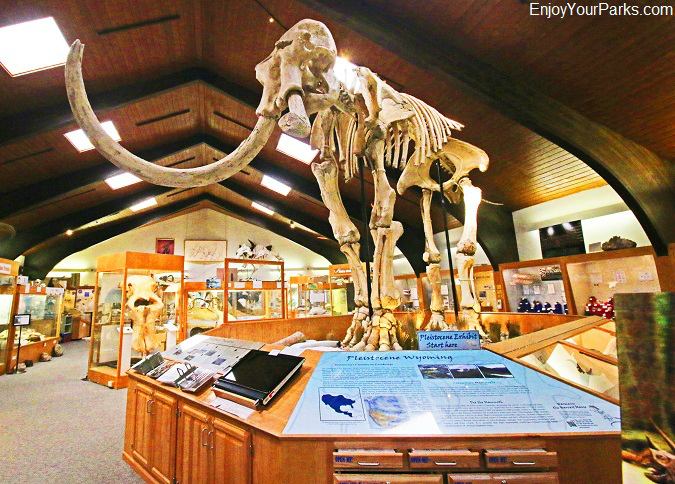
The largest mounted Columbian Mammoth in North America at the Tate Geological Museum in Casper.
Fort Caspar Historic Site and Fort Caspar Museum
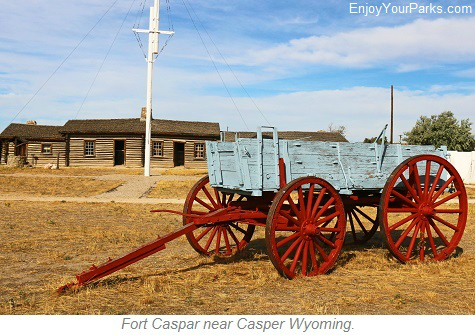 When Louis Guinard built a bridge and trading post across a major river crossing along the North Platte River in 1859, this area become an important center trade as well as becoming an overnight stage stop, telegraph office and Pony Express mail stop and a major crossing for emigrants traveling along the
When Louis Guinard built a bridge and trading post across a major river crossing along the North Platte River in 1859, this area become an important center trade as well as becoming an overnight stage stop, telegraph office and Pony Express mail stop and a major crossing for emigrants traveling along the
Oregon Trail, California Trail and Mormon Trail during the Great Westward Expansion.
Because of this area's significance, a cavalry company was ordered to "Guinard's Bridge" to guard against the increasing number of Indian raids. Then in 1865, the outpost became an official military post by the name of Platte Bridge Station. Their objective was to protect the thousands of emigrants who were using the Oregon Trail, California Trail and Mormon Trail from Indian raids as they worked their way West on wagon trains. Several famous Indian battles occurred here, including the 1865 Battle of the Platte Bridge Station, where 2nd Lieutenant Caspar Collins was killed. The name of the fort was changed to Fort Caspar shortly after this historic battle.
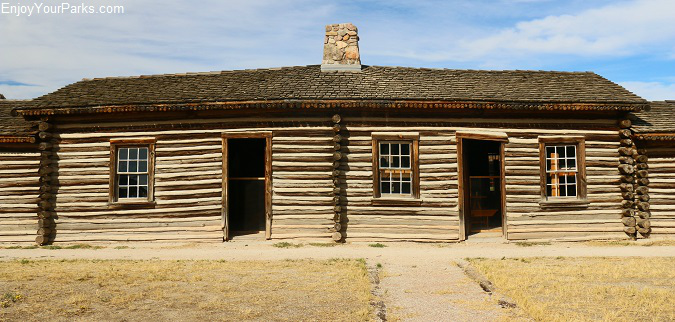
Fort Caspar Historic Site, Casper Wyoming.

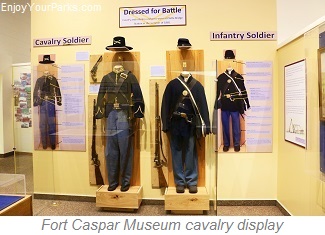
Today, visitors can enjoy tours of the reconstructed 1865 Fort Caspar Military Fort at this historic North Platte River Crossing for the Oregon Trail, Mormon Trail, California Trail, Pony Express National Historic Trail, and Transcontinental Telegraph Trail Corridor. At this location is the amazing Fort Caspar Museum, which walks you through the fantastic history of the area. The Fort Caspar Historic Site and Fort Caspar Museum is truly a "must see" for anyone interested in Western history. Literally "All Trails Come Through Here", and with it comes remarkable history that is well worth learning about.
Top Things To See In Casper Wyoming
Below is a list of the major attractions that we highly recommend that you look through and choose which ones interest you and your family. All we can say is every one of these attractions that we listed below are top notch and very much worth exploring during your time in the Casper Wyoming Area:
Independence Rock State Historic Site
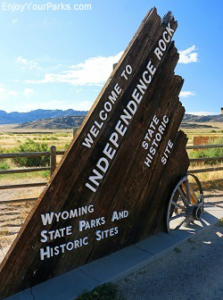 Located 50 miles southwest of Casper, Wyoming along Highway 220 is Independence Rock National Historic Landmark. Known as "The Register of the Desert", Independence Rock was a very important landmark for pioneers as they worked their way across the Great American West.
Located 50 miles southwest of Casper, Wyoming along Highway 220 is Independence Rock National Historic Landmark. Known as "The Register of the Desert", Independence Rock was a very important landmark for pioneers as they worked their way across the Great American West.
Hundreds of pioneer names have been carved into the stone... many of them travelers along the Oregon Trail, California Trail, Mormon Trail and Pony Express Trail during the Great Western Migration of the mid 1800s. These wagon trains had an important goal of reaching Independence Rock before the 4th of July, as this would assure the pioneer emigrants that they would likely make it through the Rocky Mountains before winter. At the Independence Rock State Historic Site, there are fascinating interpretive signs as well as a mile long foot trail that takes visitors completely around this historic landmark.
In addition to Independence Rock, this area is also home to several other significant historical places, such as Martin's Cove, Hell's Gate and Mormon Handcart Historic Sites.
Click Here for Details on Independence Rock State Historic Site.





